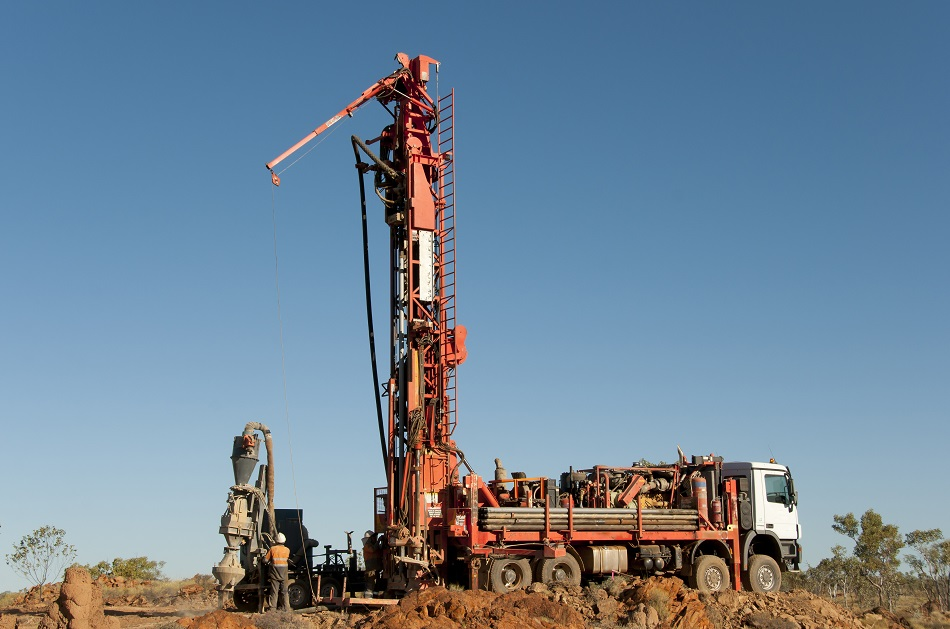
Image Credit: Adwo/Shutterstock.com
Reverse circulation (RC) drilling has become standard practice in most mines across the world.
First developed in Australia in the 1970s, the drilling technique was originally conceived as a solution to the drilling difficulties encountered when using open hole techniques in soft iron ore and mineral sands.
The first RC drill rods were adapted from the US oil industry and manufactured in Western Australia in 1972 by Bruce Metzke and John Humphries.
Drill Structure
An RC drill is usually a large piece of apparatus that requires a lot of space - not just for the rig itself - but for the supporting vehicles and the pit for collecting waste.
The drill cuttings are transferred to the surface inside drill rods, which are linked together to create a ‘drill string’. Drill bits attached to the end of the hammer are made from tungsten-steel, and are usually around 13-20cm in diameter. These also have metal nodules attached at the end to allow cutting through particularly tough rock.
Most RC drilling uses dual-tube drill rods, with one tube inside another. The tubes overlap inside and provide a path for drilled rock from the ground to the surface.
Inner tubes can be sealed together, meaning that the RC drill can sample very large depths, often around 500m.
Another type of RC drilling is ‘center sample’ drilling. This is a modern variation, in which a central hammer with a hollow center, allows the sample to immediately enter the drill pipe, without the need to travel past the hammer.
Sample Extraction
The samples produced from RC drilling are dry chips of the drilled rock.
To create the sample, the hammer acts as a pneumatic piston and pushes a tungsten-steel drill bit on to the rock to break it up. Before the drill bit hits the rock, it is dried out using an air compressor, so that the rock chips are dry at the surface.
Water is often used down the hole to cool the drill bit and reduce dust as well as assisting with the transportation of sample bits to the surface.
Air is blown down the drill rods to create a pressure difference, allowing the sample chips and water to rise through the inner tube. The sample then reaches a bell at ground level, which transports the sample to a cyclone where it dries out and is deposited into sacks.
Reverse circulation drilling method
When it is at the surface, an exploration geologist will analyze and log the sample to ascertain the prospective mineralization within the drilled orebody. A representative sample is taken from the sack and is sieved to remove excess dust. Once the desired sample has been washed and dried, the exploration geologist will note the weight percentage of the desired minerals in the sample. The samples will then be stored in plastic cutting boxes before being the subject of further chemical analysis offsite.
RC drills can occasionally get parts stuck in the ground as the drill bit wears down and the rods need to be recovered as they are very expensive. This can be a time consuming process and can on occasion set a project back by weeks. To combat this, many companies will consistently re-grind the tungsten nodules off the drill bit.
Applications
RC drilling is a technique used in the majority of stages of mine development.
As it is cheaper than diamond core drilling, it is often used in first stage exploration mining to delineate a potentially extractable ore body. It is also preferable to RAB or air-core drilling when trying to reach great depths, but RC drilling is slower and more expensive than either of these two methods.
RC drilling is also consistently used during in-pit grade control and the development stage of an ore body.
Health and Safety
There are many inherent risks involved in operating large mining equipment and RC drilling is no exception. Personal Protective Equipment must be worn at all times, which includes hearing protection, gloves, goggles, suitable footwear and dust masks as appropriate.
Companies Involved in RC Core Drilling
Here are several examples of RC drilling contractors, who specialize in RC drilling:
- Midnight Sun Drilling Co. Ltd.: Founded in 1970, MSD was the first to use the Center Sample Hammer in Canada and is still under the same management.
- SBD Group: A large group based in Western Australia, which undertakes drilling in Western Australia and West Africa.
- Leon Marsh Drilling: Based in Western Australia and specializing in exploration RC drilling.
- Atlas Copco: A large drilling company, involved in exploration drilling, geotechnical engineering and rock reinforcement.
Sources and Further Reading
This article was updated on 3rd February, 2020.
Disclaimer: The views expressed here are those of the author expressed in their private capacity and do not necessarily represent the views of AZoM.com Limited T/A AZoNetwork the owner and operator of this website. This disclaimer forms part of the Terms and conditions of use of this website.